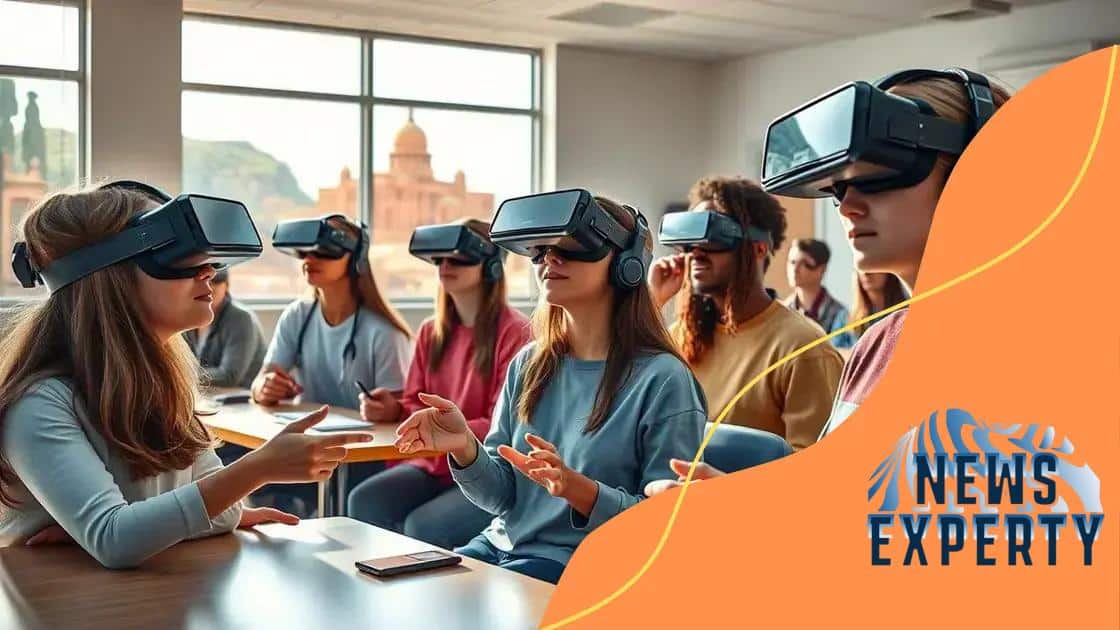The benefits of experiential learning through virtual reality

Anúncios
The benefits of experiential learning through virtual reality include enhanced student engagement, personalized learning experiences, practical skill application, and increased accessibility to quality education across diverse environments.
The benefits of experiential learning through virtual reality are staggering. Imagine stepping into a virtual world where you can practice skills and explore concepts firsthand. This approach is changing the game for learners everywhere, making education more interactive and engaging.
Anúncios
Understanding experiential learning
Understanding experiential learning is key to grasping its significance in education. Experiential learning emphasizes learning through experience, allowing students to engage actively and reflect upon their learning process. This method goes beyond traditional lectures by immersing students in real-life scenarios, which aids in better retention of knowledge.
Key Characteristics of Experiential Learning
Experiential learning is not just about participation; it’s about transformation. Students learn effectively when they can connect theory to practice. The following elements highlight the core characteristics of this approach:
- Active Engagement: Students participate in hands-on activities that relate to their learning objectives.
- Reflection: After experiences, students reflect on what they learned and how they can apply it.
- Real-World Relevance: Learners see practical solutions and gain insights into actual situations.
- Personal Involvement: Each learner’s experiences add depth, making learning personal and impactful.
In addition to these characteristics, experiential learning encourages collaboration among students. When learners work together on projects or simulations, they not only exchange ideas but also develop essential skills such as teamwork and communication.
Anúncios
The Role of Feedback
Another important aspect of experiential learning is the role of feedback. As students engage in activities, providing immediate feedback helps reinforce concepts and encourages deeper understanding. This practice creates a loop where students learn, assess their performance, and improve continuously.
Moreover, experiential learning is applicable across various fields. For example, in medical training, students gain practical skills by working in simulation environments; in business, they can undertake internships that give them insight into real-world operations. This versatility makes experiential learning an invaluable teaching method.
How virtual reality enhances learning
How virtual reality enhances learning is a topic gaining much attention in education. Virtual reality (VR) creates immersive environments that allow learners to experience scenarios that would be impossible or impractical in real life. This technology not only captures attention but also fosters deeper comprehension.
Immersive Experiences
Through VR, students can step into different worlds. For instance, they may explore ancient civilizations or dive deep into the ocean. These vibrant experiences create lasting memories, helping students retain information more effectively than traditional learning methods.
- Engages multiple senses: With sights and sounds, VR enhances the learning experience.
- Encourages exploration: Students can navigate environments at their own pace, making discoveries along the way.
- Promotes empathy: Experiencing situations from different perspectives can foster understanding.
This technology also promotes active learning. Instead of passively absorbing information, students engage with content and apply what they learn in real-time. By interacting with 3D models and simulations, learners can test hypotheses and observe outcomes instantly.
Real-Time Feedback
Another significant benefit of VR is real-time feedback. In a traditional classroom, feedback can sometimes take time to filter back to students. However, in a VR environment, learners receive immediate responses to their actions. This instant feedback loop encourages them to adjust their approaches and improves understanding quickly.
Moreover, VR can cater to diverse learning styles. Visual learners benefit from 3D environments, while kinesthetic learners thrive on interaction. By accommodating varying preferences, VR promotes inclusivity and ensures that every student can engage meaningfully.
In addition, VR can simulate high-stake scenarios. Trainees in areas like medicine or aviation can practice crucial skills without any real-world risks. For example, medical students can perform virtual surgeries, gaining experience and confidence before facing real patients.
Real-world applications of VR in education

Real-world applications of VR in education are revolutionizing teaching methods. Schools and institutions worldwide are adopting virtual reality to enhance the learning experience. By bringing subjects to life, VR makes education more engaging and applicable.
Field Trips in the Classroom
One exciting application is through virtual field trips. Instead of traveling, students can explore landmarks, museums, and historical sites from their classrooms. This not only saves time and costs but also allows students to visit places they might never have the chance to see in person.
- Enhances understanding of different cultures.
- Provides experiences that are often more memorable than traditional lessons.
- Encourages curiosity and questions through interactive exploration.
Additionally, VR can transform science lessons into immersive experiences. For instance, biology students can virtually dissect a frog or explore the human body’s systems in 3D. Such hands-on experiences deepen understanding and retention.
Skill Development and Training
Another significant use of VR is in skill development and training. Fields such as medicine, aviation, and engineering benefit immensely from this technology. Medical students, for example, can perform virtual surgeries, practicing their skills in a risk-free environment. This not only builds confidence but also enhances their ability to handle real-life situations.
Moreover, training programs can simulate high-pressure scenarios such as emergency responses. This helps trainees learn how to react swiftly and effectively when faced with real-life challenges.
In vocational education, VR allows learners to practice in environments that mirror their future workplaces. For example, construction students can navigate building sites, ensuring they understand safety protocols and procedures without being on an actual site.
Benefits for educators and trainers
Benefits for educators and trainers are significant when incorporating virtual reality (VR) into the learning process. This innovative technology not only enhances student engagement but also provides unique opportunities for teaching. Educators and trainers who leverage VR can transform traditional lessons into immersive experiences, resulting in better learning outcomes.
Increased Engagement
One of the primary benefits of VR for educators is increased student engagement. Students are more likely to pay attention and participate when learning in a virtual environment. This immersive experience captivates learners, making them more active participants instead of passive observers.
- Students can visualize complex concepts.
- Engagement levels rise with interactive tasks.
- Experience-based learning helps in retaining information.
Moreover, VR fosters a sense of excitement around learning. This excitement can lead to improved classroom dynamics and a more positive attitude towards education.
Customized Learning Experiences
Another advantage is the ability to create customized learning experiences. Educators can tailor virtual reality sessions to meet specific learning objectives. For example, a biology teacher can design a VR module that allows students to explore the intricacies of the human body. This personalized approach makes learning more relevant and impactful.
In addition, VR allows educators to cater to varied learning styles. Kinesthetic learners can engage through hands-on activities, while visual learners benefit from stunning visuals. This adaptability makes VR a powerful tool for inclusive education.
Furthermore, trainers can utilize VR for professional development. By simulating real-world scenarios, trainers can prepare employees for high-stakes situations without any risks involved. This practical training method enhances skills and confidence among trainees.
Future trends in virtual reality learning
Future trends in virtual reality learning promise to transform education even further. As technology advances, the integration of virtual reality (VR) into learning environments will become more comprehensive and effective. Educators and students alike can look forward to innovative features that enhance education.
Increased Accessibility
One key trend is the increased accessibility of VR technology. As hardware becomes more affordable, more classrooms will adopt VR tools. This wider reach will allow diverse learners to benefit from immersive experiences regardless of their geographical location. Imagine students in remote areas accessing high-quality educational content through VR.
- More schools will have access to VR resources.
- Cost-effective solutions will emerge, making VR widespread.
- Global collaborations could occur with virtual classrooms.
This accessibility will encourage inclusivity, allowing all students to engage with interactive learning materials.
Advancements in VR Content
The development of more sophisticated content is another exciting trend. Future VR programs will feature improved graphics, enhanced interactivity, and new ways for students to engage. For example, students might use VR simulations to conduct scientific experiments in virtual labs, making even the most complex subjects easy to comprehend.
Additions like artificial intelligence could personalize learning experiences. AI can adapt content based on each learner’s pace and understanding, promoting a tailored educational journey.
Moreover, collaboration among students in virtual spaces may become common. Learners could work together on projects, share insights, and provide peer feedback, all while immersed in the same virtual environment. This teamwork will cultivate valuable skills like communication and problem-solving.
Incorporating virtual reality into professional training will also see growth. Businesses may use VR for onboarding processes and employee training, reducing costs associated with in-person training sessions. This trend ensures employees gain practical skills while minimizing disruptions at the workplace.
FAQ – Frequently Asked Questions about Virtual Reality in Education
How does virtual reality enhance student engagement?
Virtual reality captures students’ attention by immersing them in interactive environments, making lessons more engaging and memorable.
What are the benefits of personalized learning through VR?
Personalized learning through VR tailors educational experiences to individual needs, allowing students to learn at their own pace and style.
Can VR be used for real-world training?
Yes, VR is excellent for simulating real-world scenarios, helping students and professionals practice skills in a safe environment without real-life risks.
What are some future trends in virtual reality learning?
Future trends include increased accessibility of VR technology, advancements in content quality, and more collaborative learning opportunities for students.





